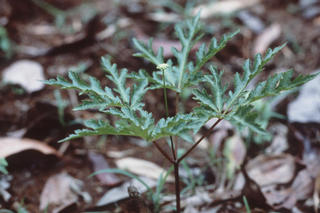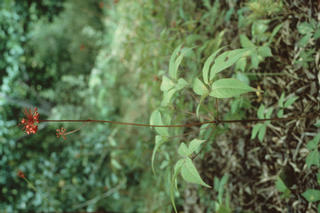Panax japonicus var. bipinnatifidus
Contents
Nomenclature
Other Names:
Historical Use of Panax japonicus var. bipinnatifidus
Panax japonicus var. bipinnatifidus in Traditional Chinese Medicine
Background
Chinese Name (pinyin): Zhuzishen
Chinese Name :
Common Name :Largeleaf Japanese Ginseng Rhizome
Specific Name : Rhizoma panacis majoris
Scientific Name:
Collection : The drug is collected in autumn, removed from rough bark and rootlet, dried or dried after steamed (boiled) thoroughly.
Description : Slightly cylindrical or irregular oblate, occasionally beaded, 0.5 - 2.8 cm in diameter. Externally brownish yellow or yellowish brown with distinct warty protrudings and wrinkles, occasionally with rounded sunken stem scars, sometimes remaining fine internodes laterally or bilaterally. Texture hard fracture uneven, pale yellowish white, starchy. Odour slight; taste, bitter and slightly sweet with irritating sensation.Steamed or boiled rhizomes: Transversely cut surface, yellowish white or yellowish brown, slightly horny, taste slightly sweet and bitter, not irritating or chewing.
Identification : 1.Transverse section: Cork consisting of several layers of cells. Cortex slightly narrow with rounded or oblong secretory ducts, 32 - 500 µm in diameter surrounded by 5 - 18 secretory cells. Secretory ducts in phloem relatively small. Cambium ring interrupted. Vessels up to 76 µm in diameter arranged radially or in V-shape. Medullary rays wide. Pith in the center. Parenchymatous cells containing starch granules and some containing clusters of calcium oxalate.2.Macerate 1 g of the powder in 10 ml of water over night then warm for 10 minutes and filter immediately. Transfer 1 ml of each of the filtrate to two test tubes with stopper, add two ml of sodium hydroxide TS to one tube and 2 ml of hydrochloric acid solution (1Õ20) to another, shake vigorously for 1 minute. The height of the foams produced in the acid tube in two times as high as that in the alkali tube.3.Shake 0.5g of the powder with 5 ml of ethanol for 30 minutes and filter. Evaporate the filtrate to dryness, add dropwise a saturate solution of antimony chloride in chloroform, evaporate to dryness again, a purple color is produced4.To 1 g of the powder add 5 -10 drops of water and stir well. Add 10 ml of n-butanol solution saturated with water, stopper tightly, shake for about 10 minutes and allow to stand overnight, filter and evaporate to dryness. To the residue, add 10 ml of a mixture of sulfuric acid and 30% ethanol (1Õ20), heat under reflux for 2 hours and extract with 20 ml of chloroform. Wash the chloroform extract with 10 ml of water (centrifuge if necessary). Dissolve the residue in 1ml of methanol as the test solution. Dissolve olealonic acid CRS and panaxadiol CRS to produce a mixture containing 1.5 mg of olealonic acid CRS and 0.5 panaxadiol CRS as the reference solution. Carry out the method for thin layer chromatography (Appendix Vl B), using silica gel G as the coating substance and benzene-ethyl acetate (1:1) as the mobile phase. Apply separately to the plate 10 µl of each of the two solutions. After developing and removal of the plate, dry it in the air. Spray with sulfuric acid solution (1Õ10), heat at 105ºC for about 10 minutes. Examine under ultra-violet light (365 nm). The fluorescence spots in the chromatogram obtained with the test solution correspond in position and color to the spot in the chromatogram obtained with the reference solution.
Processing : Eliminate foreign matter, pound to pieces before use.
Action : To nourish yin and replenish the lung, to promote the flow of qi in collaterals, and to arrest bleeding.
Indication : deficiency of both qi and yin characterized by fever and thirst, cough in consumptive diseases; traumatic injuries, joint pain; hemoptysis, hematemesis, traumatic bleeding
Precautions :
Dosage : 3 to 9 g; for exteranl use, appropriate quantity to be ground into powder and applied topically.
Storage : Preserve in a dry place, protected from moth.
Synonymns for Panax japonicus var. bipinnatifidus
Patent Medicines and Medicines with Multiple Ingredients that include Panax japonicus var. bipinnatifidus
Pharmaceutical Information
Chemical Constituents
Evidence or the Use of Panax japonicus var. bipinnatifidus in the Treatment of Epilepesy
Basic Science
Animal Studies
Cohort, Case-Control and Non-Randomized Trials
Randomized Controlled Trials
Meta-Analysis
1st Five Results: pubmed search
Bin Rui Yang, Sze Chung Yuen, Guang Yi Fan, Wei-Hong Cong, Siu-Wai Leung, Simon Ming-Yuen Lee
Identification of certain Panax species to be potential substitutes for Panax notoginseng in hemostatic treatments.
Pharmacol Res: 2018, 134;1-15
[PubMed:29772270]
[WorldCat.org]
[DOI]
(I p)
Yun Li, Yuan-zhong Wang, Wei-ze Yang, Shao-bing Yang, Jin-yu Zhang, Fu-rong Xu
[Study on the Genetic Relationship of Panax Notoginseng and Its Wild Relatives Based on Fourier Translation Infrared Spectroscopy].
Guang Pu Xue Yu Guang Pu Fen Xi: 2016, 36(8);2420-4
[PubMed:30074340]
[WorldCat.org]
(P p)
Shaopeng Zhang, Rufeng Wang, Wanyong Zeng, Wenjun Zhu, Xifeng Zhang, Chong Wu, Jia Song, Yonglian Zheng, Ping Chen
Resource investigation of traditional medicinal plant Panax japonicus (T.Nees) C.A. Mey and its varieties in China.
J Ethnopharmacol: 2015, 166;79-85
[PubMed:25771357]
[WorldCat.org]
[DOI]
(I p)
Shu Zhu, Kun Zou, Hirotoshi Fushimi, Shaoqing Cai, Katsuko Komatsu
Comparative study on triterpene saponins of Ginseng drugs.
Planta Med: 2004, 70(7);666-77
[PubMed:15303259]
[WorldCat.org]
[DOI]
(P p)
D Q Wang, J Fan, B S Feng, S R Li, X B Wang, C R Yang, J Zhou
[Studies on saponins from the leaves of Panax japonicus var. bipinnatifidus(Seem.)Wu et Feng].
Yao Xue Xue Bao: 1989, 24(8);593-9
[PubMed:2618703]
[WorldCat.org]
(P p)

